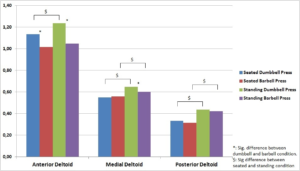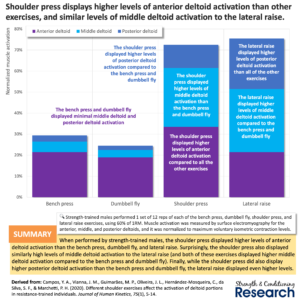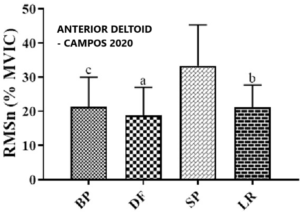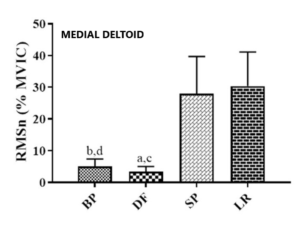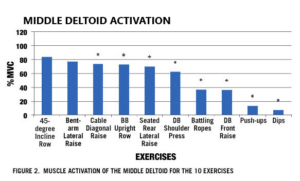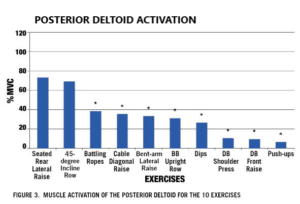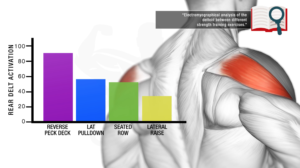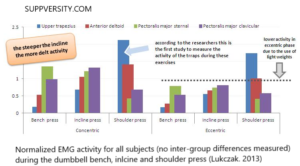OVERHEAD PRESS
Click on Image to Enlarge
EMG STUDIES
ANTERIOR, MIDDLE & POSTERIOR DELTOID
– Overhead Press BB vs. DB
Effects of Body Position and Loading Modality on Muscle Activity and Strength in Shoulder Presses – 2013 – Saeterbakken
Subjects
– participants had 5.0 ± 2.6 years of strength-training experience but were not competitive power lifters or Olympic weightlifters
Procedure
– EMG testing 80% 1RM
Results for Overhead Press
Anterior Deltoid 120% to 100%: standing db . seated db . standing bb . seated bb
Middle Deltoid 65% to 55%: standing db . standing bb . seated bb . seated db
Posterior Deltoid 40% to 30%: standing db . standing bb . seated db . seated bb
– the exercise with the greatest stability requirement (standing and dumbbells) demonstrated the highest neuromuscular activity of the deltoid muscles, although this was the exercise with the lowest 1RM strength
ANTERIOR, MIDDLE & POSTERIOR DELTOID
– Overhead Press vs. Lateral Raise
Different Shoulder Exercises Affect the Activation of Deltoid Portions in Resistance-Trained Individuals – 2020 – Campos
Procedure
– 13 men experienced in strength training; maximum isometric voluntary contraction (MVIC); one set of 12 repetitions with the load of 60% 1RM
Exercises
(1) bench press: 165% bi-acromial distance with the elbows extended; lowered bb until shoulders reached a horizontal abduction of approx 45⍛ below the trunk line
(2) dumbbell fly: lowered db until shoulders reached a horizontal abduction of approx 45⍛ below the trunk line
(3) shoulder press overhead – seated back to upright bench: 135° shoulder adduction
(4) lateral raise – thumbs up – seated back to upright bench: perform 90⍛ of shoulder abduction from the anatomical position
Results
Anterior or Front Deltoid: shoulder press 35% . lateral raise thumbs up 20% . bench press 20% . db flye 20%
Lateral or Middle Deltoid: lateral raise thumbs up 30% . shoulder press 30%
Posterior or Rear Deltoid: lateral raise thumbs up 25% . shoulder press 10%
ANTERIOR, MIDDLE & POSTERIOR DELTOID
– DB Overhead Press, DB Lateral Raise, Low Cable Lateral Raise, Reverse Fly, 45º Incline Row
ACE Reseach – Top Shoulder Exercises – 2015 – Sweeney – PDF Thesis .
Procedure
– all of the subjects were required to have some weight-lifting experience and attended one mandatory practice session
Exercises
DB Overhead Press
Bent Arm DB Lateral Raise thumbs neutral . Straight Arm Cable Lateral Raise
Seated Rear Lateral Raise – Reverse Fly . 45º Incline Row elbows out
Results
Anterior Deltoid: DB OHP 75% . DB Front Raise 55%
Lateral Deltoid: Incline Row 85% . DB Lateral Raise 80% . Cable Lateral Raise 75% . BB Upright Row 70% . Seated Rev Fly 70% . DB OHP 60%
Posterior Deltoid: Seated Reverse Fly 75% . Incline Row 70%
ANTERIOR, MIDDLE & POSTERIOR DELTOID
– Lateral Raises, Reverse Pec Deck, Incline Lat Pulldown, Seated Machine Row
– Shoulder Press, Bench Press, Pec Deck
EMG of the Deltoid Between Different Strength Training Exercises – 2013 – Botton, Wilhelm, Pinto, Ugjni, Lima
Subjects
– at least six months strength training
Exercises
Smith Machine Shoulder Press; Bench Press; Pec Deck
DB and Cable Crossover Lateral Raises
Seated Row elbows up – seated upright; pronated grip; shoulders abducted to 90°; horizontal shoulder extension
Reverse Pec Deck – neutral grip and elbows straight, performing horizontal shoulder extension
Incline Lat Pull elbows up – posterior tilt position so that the cable of the machine was perpendicular to the body.
Results
Anterior Deltoid: Smith Shoulder Press 70% . Bench Press 55% . Pec Deck 50%
Lateral Deltoid: DB Lateral Raise 55% . Cable Lateral Raise 55% . Reverse Pec Deck 50% . Seated Row 40% . Smith Shoulder Press 25%
Posterior Deltoid: Reverse Pec Deck 90% · Inclined Lat Pulldown 55% · Seated Row 50% . DB Lateral Raises 35% . Cable Lateral Raise 35%
UPPER-MIDDLE-LOWER TRAPS + SERRATUS ANTERIOR
– Prone Flexion “Y”, Prone Ab-duction “T”, DB Row, DB Overhead Press
Scapular Muscle Activity from Selected Strengthening Exercises Performed at Low and High Intensities – 2011 – Andersen
– Seventeen women (aged 24-55 years) without serious disorders participated
Results – High Intensity
Upper Traps: Prone Flexion “Y” 75 · Prone Abduction “T” 70 · Overhead Press 60
Middle Traps: Prone Abduction “T“ 90 · One Arm Row 70 · Prone Flexion “Y” 70
Lower Traps: Prone Flexion “Y” 70 · Prone Abduction “T” 70 · One Arm Row 50
Serratus Anterior: Overhead Press 80 · Pushup Plus 70 · Prone Flexion “Y” 55
Exercises
1. DB Prone abduction with external rotation “T“: bench; abduct shoulders with thumbs pointing up until upper arm is horizontal; elbows slightly flexed
2. DB Prone flexion “Y”: bench; flex shoulders with thumbs pointing up until upper arm is horizontal, elbows slightly flexed
3. DB Shoulder (Overhead) Press: sit upright; DBs in front of the shoulders; push DBs straight up until the arms are straight
4. DB One-arm row: 30º from horizontal; one knee on the bench; pulls DB toward the ipsilateral lower rib
5. Push-up plus: push-up position on hands and feet or knees; keep torso rigid; push the body as high as possible off the floor by protracting the scapulas
6. Press-up: sit upright, feet on floor; straight arms; palms on edge of bench fingers pointing forward; dip down moving just the shoulder girdle
7. Ring fallouts: on the knees with the hands in the gymnastic rings, which are suspended just above the ground level
PECTORALIS MAJOR UPPER & MIDDLE + UPPER TRAPEZIUS
– DB Press Flat vs. DB Press 45º Incline vs. DB 85º Overhead
Shoulder Muscle Activation of Novice and Resistance Trained Women during Variations of DB Press Exercises – 2013 – Luczak, Bosak, Riemann
Procedure
– collegiate-aged female resistance trained individuals and novice female resistance trained exercisers
– using 4.5 kg dumbbells
Electrode Placement
1. clavicular portion of the pectoralis major, electrodes were placed four finger widths below the medial clavicle just medial to anterior axillary border
2. sternal portion, electrodes were placed four finger widths below the sternoclavicular joint; Note: this would the sternal or middle region
3. anterior deltoid, electrodes were placed at one finger width distal and anterior to the acromion.
4. upper trapezius, electrodes were placed at 50% of the distance between the acromion process and the spine of the seventh cervical vertebra.
Results – Concentric
– No significant differences were found between experienced and novice resistance trained individuals; Note: a very light weight was used
Pectoralis – Clavicular or Upper Region: 45°db incline 175% · db flat bench 130% · 85°db overhead 90%
Pectoralis – Sternal or Middle Region: db flat bench 130% · 45°db incline 115% · 85°db overhead 90%
Anterior Deltoid: 85°db overhead 355% · 45°db incline 265% · db flat bench 130%
+ Upper Trapezius: 85°db overhead 1165% · 45°db incline 375% · db flat bench 100%
.

